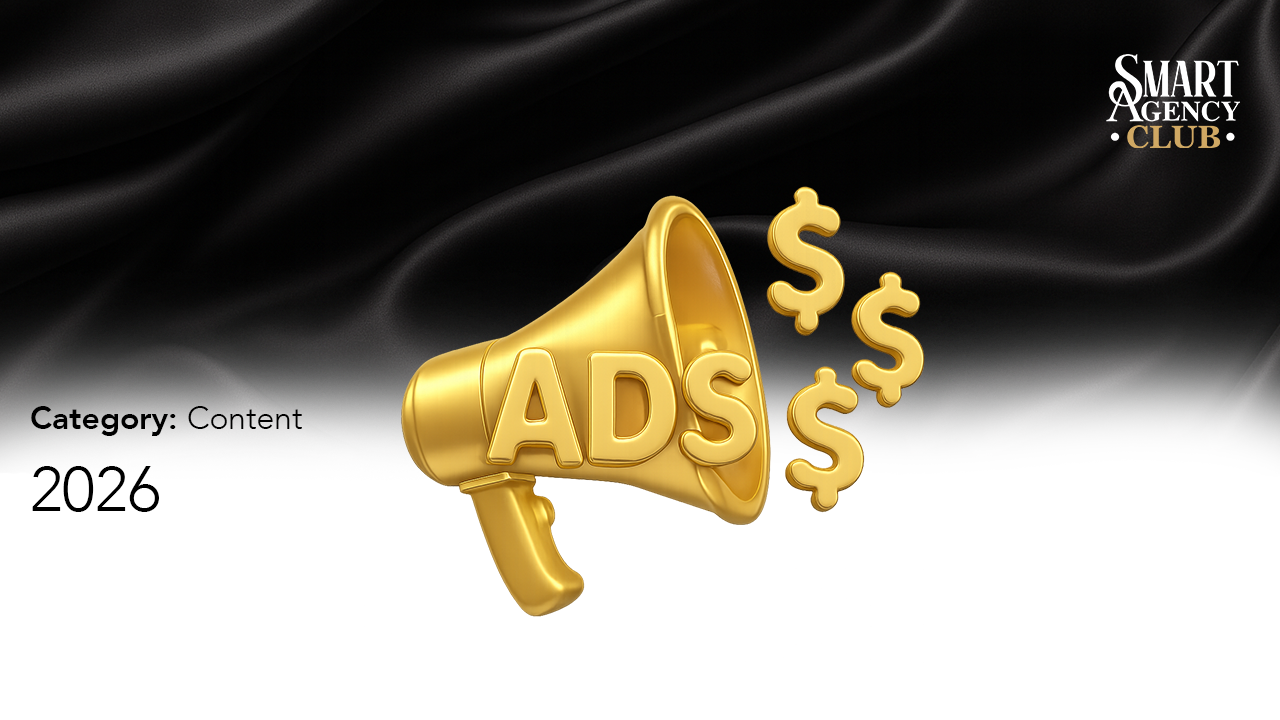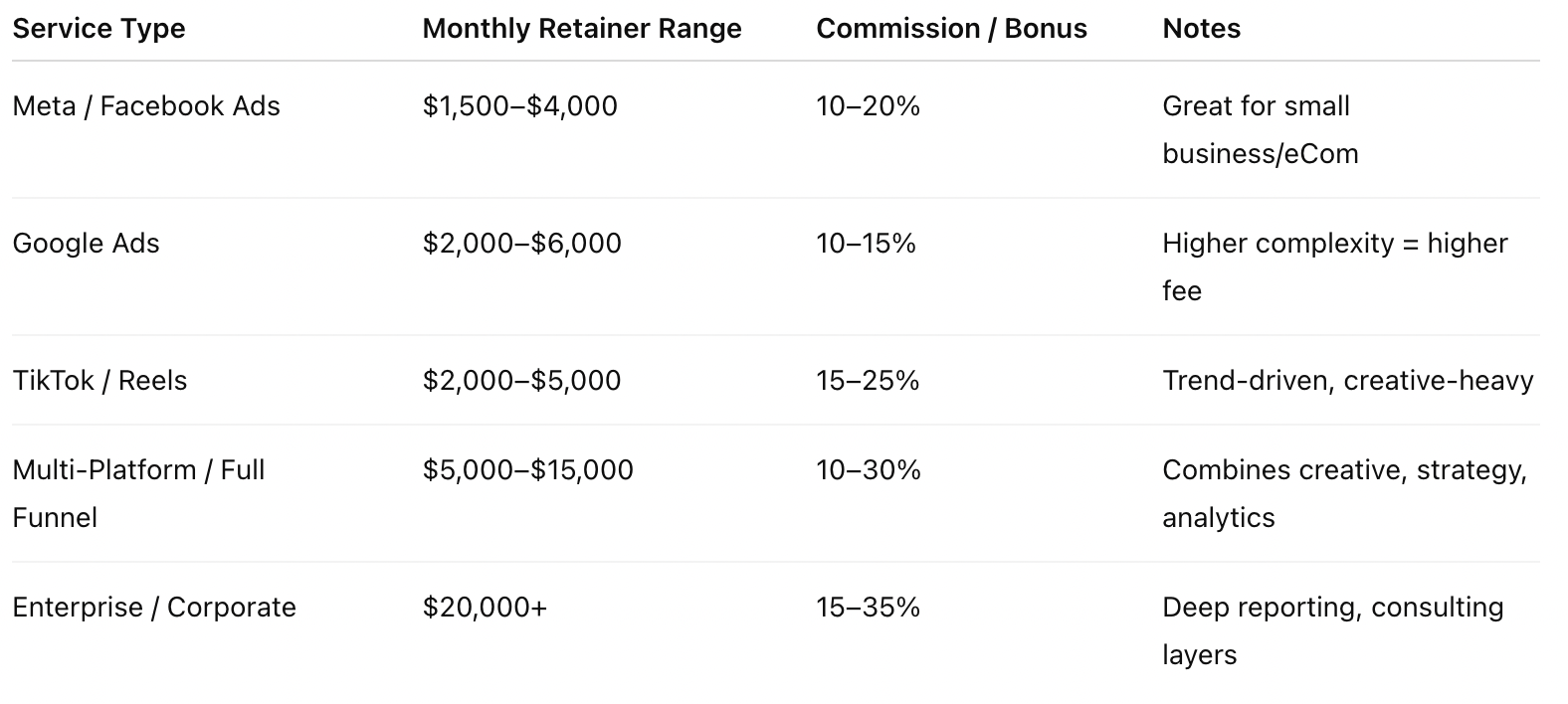
How Much to Charge Clients for Advertising Services in 2026
Jun 26, 2025Setting the right price for your advertising services in 2026 isn’t just a numbers game — it’s positioning, psychology, and profitability combined.
Ad costs are climbing, competition is global, and clients today are smarter, more ROI-focused, and more skeptical than ever. How you price your services doesn’t just determine your income — it defines your authority.
This guide walks you through the Smart Agency Club approach to pricing: value-first, psychology-driven, and designed to make clients say “that’s more than fair” while you maintain healthy margins.
💡 1 | The Psychology Behind Profitable Pricing
If you’ve ever wondered why some agencies charge $2,000 and others $20,000 for seemingly similar services, the answer isn’t deliverables — it’s perception.
Clients don’t buy your hours. They buy your certainty.
The most profitable agencies in 2025 understand this and base their prices on value — not effort.
Here’s your guiding formula:
Outcome Value × Trust Multiplier = What You Can Charge
If your strategy helps a client generate $100,000 in new profit, and your process inspires confidence, a $10,000 fee is logical — even attractive.
That’s the foundation of value-based pricing. When you price on results and back it with proof and positioning, resistance drops, conversions rise, and your profit margins expand.
Practical tip:
Stop justifying your price with time or tasks (“it’ll take 10 hours” or “it includes weekly reports”). Instead, link your price to outcomes and emotions — confidence, growth, and peace of mind.
💸 2 | The Four Pricing Models Agencies Use in 2026
There’s no universal “correct” pricing structure — but there are proven frameworks that keep your business profitable and clients happy. In 2026, these four will dominate:
1. Flat Retainer (Stability Model)
Charge a fixed monthly fee — e.g., $3,000–$10,000/mo.
✅ Predictable revenue.
✅ Easier cashflow forecasting.
⚠️ Make sure you clearly define scope; otherwise, you’ll find yourself doing unpaid extra work.
Best for: smaller businesses, consistent campaigns, or clients who want simplicity.
2. Percentage of Ad Spend
Take 10–20% of total ad spend. Works best with high-budget clients ($20k+/mo in ads).
✅ Scales naturally as clients grow.
⚠️ Watch for misalignment if they want to reduce spend — your fee drops even if workload doesn’t.
Best for: experienced media buyers managing large, performance-based accounts.
3. Performance-Based Pricing
Earn a share (10–30%) of the revenue or profit you generate.
✅ Aligns your success with theirs.
⚠️ You’ll need clear attribution, transparency, and trust — or disputes follow.
Best for: agencies confident in their ability to track results precisely.
4. Hybrid Model (Risk-Balanced Pricing)
This is what we teach inside Smart Agency Club — a base retainer (covers costs + margin) combined with a performance bonus when you exceed KPIs.
✅ You protect your floor.
✅ Clients see you as “invested in their success.”
Best for: agencies seeking scalable, win-win client relationships.
Example hybrid: $4k/month base + 10% of revenue above baseline.
If you deliver $50k in new profit, you earn an extra $5k — motivating for both sides.
📊 3 | 2025 Industry Benchmarks
Use the following as directional benchmarks — not limitations. Rates fluctuate by geography, niche, and expertise level.

Pricing is storytelling — and the story you tell determines your perceived worth.
🔍 4 | Extended Benchmarks & Market Context
Pricing also flexes across industries, maturity levels, and conversion cycles:
-
E-commerce brands: Require fast iteration, creative testing, and dynamic remarketing. $5k–$12k/month is common.
-
Local-service businesses: Simpler campaigns, smaller ad spends. $1.5k–$4k/month typical.
-
SaaS, info-product, or education brands: Longer funnels and complex data tracking. $8k–$20k retainers are standard, plus bonuses.
Clients don’t really compare your price to another agency’s; they compare risk versus reward.
Your job is to demonstrate that hiring you minimizes risk and amplifies return — when that belief lands, price becomes secondary.
Pro tip:
Always tie your fee to financial upside. Show clients that working with you doesn’t “cost” $5k — it earns them multiples of that.
🧠 5 | Value Framing — How to Make Any Price Feel Small
This is the invisible advantage behind every high-performing agency.
You don’t sell “ad management.” You sell growth predictability.
You don’t sell “Facebook ads.” You sell sales velocity.
When you shift from service-based framing to value-based framing, clients stop asking “how much?” and start asking “how soon can we start?”
| Generic Pitch | Smart Agency Pitch |
|---|---|
| “We manage your ads.” | “We engineer predictable profit systems.” |
| “We’ll optimize your CPC.” | “We’ll uncover your biggest ROI leaks and fix them within 30 days.” |
| “We’ll post creative content.” | “We’ll craft conversion-driven campaigns that multiply sales.” |
Your pitch should help them visualize profit, not process.
That’s what we call value stacking inside Smart Agency Club — turning deliverables into ROI multipliers.
⚖️ 6 | The Decoy Pricing Framework
Want clients to choose your mid-tier offer (the one with your best profit margin)? Introduce a decoy.
Offer three clear packages:

The middle package becomes the “obvious choice” when anchored between a lower and higher option.
That’s cognitive bias — and it’s ethical psychology. You’re not manipulating; you’re structuring options so clients can self-select based on value.
Pro tip:
Make the “Growth” plan look premium by comparison — not cheap. Include language like “most popular” or “best for scaling results fast.”
🔐 7 | Risk Reversal — Turning “I’ll Think About It” Into “Let’s Start”
Every high-ticket sale hits a trust wall. Clients wonder, “What if it doesn’t work?”
Remove that fear with conditional guarantees that make them feel safe without putting you at risk.
Example:
“If we don’t hit your agreed-upon KPI within 90 days, we’ll continue working free until we do — provided ad spend and creative control remain consistent.”
You’re offering confidence, not charity.
When clients feel your skin is in the game, hesitation disappears.
This is your trust accelerator, and it’s a core Smart Agency Club principle — risk-sharing builds buy-in.
🧮 8 | How to Calculate Your Ideal Retainer
One of the biggest mistakes agency owners make is pulling numbers from thin air. You can calculate your rate with a simple formula:
Client’s Revenue Goal ÷ Target ROI = Ad Budget → Management Fee = 25–35% of that
Example:
A client wants an extra $100k this quarter at a 5× ROI.
That means $20k in ad budget → your monthly management fee should fall around $6k–$7k.
You’ve now linked your price to performance.
This positions you as a partner, not a vendor.
Advanced tip:
Layer in a performance clause — e.g., an additional 10% of all profits above target ROI. This both motivates and rewards you for exceptional delivery.
📈 9 | 2026 Market Shifts Impacting Pricing
🔹 Rising CPMs & Ad Costs
Meta and Google CPMs rose 8–12% globally in early 2025. That means clients will be paying more to reach the same audience.
Your expertise in optimization, creative testing, and data-driven targeting becomes more valuable than ever.
🔹 AI-Aided Advertising
Automation is leveling the playing field, but only for execution. What clients still can’t automate is strategy, psychology, and positioning.
Sell your thinking, not your clicking.
🔹 Attribution Complexity
Between iOS privacy updates, disappearing cookies, and fragmented tracking, clients are desperate for clarity.
If you can build dashboards, interpret data, and explain where ROI comes from, you’re worth a premium.
Bottom line:
AI may make campaigns easier to run, but it also raises expectations for strategic leadership — and that’s where your pricing power lies.
🚀 10 | Knowing When (and How) to Raise Your Prices
Your pricing should evolve as your reputation does.
Raise rates confidently when:
-
You’re nearing full capacity or consistently booked out.
-
Clients renew instantly without hesitation.
-
You’ve systemized your results or codified frameworks.
-
Your case studies show clear ROI.
Here’s the phrasing from the Smart Agency Club playbook:
“We’ve upgraded our campaign framework for 2026, including creative automation and advanced attribution. For new clients, pricing now starts at $X.”
It’s confident, professional, and logical — no apology, no explanation.
Pro tip:
When you raise prices, also upgrade your offer design — new bonuses, systems, or guarantees. That way, even loyal clients perceive increased value, not just higher cost.
🧾 11 | The Smart Agency Proposal Sequence
This is how you quote like a pro and close with authority:
-
Restate their goals.
(“You said your goal is to 3× sales by Q2.”) -
Present the roadmap.
(“Here’s the proven system we’ll use to get you there.”) -
Offer tiered packages.
(Anchor the ideal option in the middle.) -
Show proof.
(Social proof, metrics, testimonials.) -
Add a guarantee.
(Reduces fear.) -
Create scarcity.
(“We onboard 2 new clients per month to maintain performance.”) -
End with a confident CTA.
“Let’s explore how this could look for your brand — book your free strategy call.”
Follow this process, and you’ll never again “hope” a proposal converts — it’ll become predictable.
🧭 12 | The Smart Agency Club Edge
This entire guide draws directly from the Smart Agency Club frameworks — the same systems top-tier agencies use to package, price, and scale without burnout.
Inside the program, you’ll master:
-
Offer positioning & value stacking (to charge more confidently)
-
Decoy pricing design (to lift average deal size)
-
Conditional guarantees (to close faster)
-
Sales call frameworks (to convert with integrity)
If you found this post valuable, the course dives even deeper with templates, scripts, and real-world examples.
✅ 13 | Conclusion — Your 2026 Pricing Advantage
Your pricing isn’t just a figure — it’s your positioning.
Price too low, and clients assume you’re inexperienced.
Price confidently, and they assume you deliver results.
-
Price for transformation, not time.
-
Anchor with confidence, not comparison.
-
Sell outcomes, not activities.
The question isn’t “How much should I charge?”
It’s “How much is it costing them not to work with me?”
💥 Next Step — Book Your Free Strategy Call
Want personalized help setting your 2026 pricing system?
On your free 30-minute strategy call, we’ll:
-
Audit your current pricing and offers
-
Identify where you’re undercharging
-
Map a 90-day plan to grow revenue without extra hours
👉 Book your free strategy call now
(Limited spots weekly to ensure every session is high-value and actionable.)

